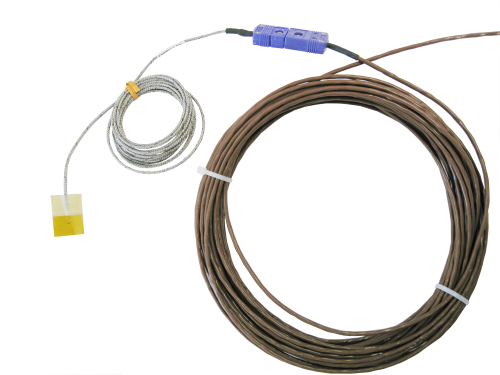
Ideal for monitoring solar panel temperatures






Resumen
El CS220 es un termopar que mide la temperatura de una superficie por contacto directo. Normalmente utilizado en una placa solar, pero puede utilizarse también para medir la temperatura de otras superficies. Este termopar se conecta fácilmente a nuestros datalogger, y es ideal en aplicaciones para energía solar.
Leer másVentajas y características
- Adecuado para aplicaciones en energía solar
- Tolerancia del termopar según ASTM E230-ANSI MC 96.1 (unión de referencia a 0°C)
- Fácil de instalar
- Compatible con la mayoría de dataloggers Campbell Scientific
Imágenes

Descripción detallada
The CS220 uses a 24-AWG, twisted pair, shielded, fast response type E thermocouple. Type E thermocouples consist of a chromel wire and a constantan wire joined at a measurement junction. A voltage potential is generated when the measurement end of the thermocouple is at a different temperature than the reference end of the thermocouple. The magnitude of the voltage potential is related to the temperature difference. Therefore, temperature can be determined by measuring the differences in potential created at the junction of the two wires.
A reference temperature measurement is required for thermocouple measurements. The temperature sensor built into many of our dataloggers' wiring panel typically provides this measurement.
The CS220 consists of a stainless-steel overbraided cable and a thermocouple extension cable. Adhesive on one end of the overbraided cable secures the sensor to the solar panel. The mini connectors of the thermocouple extension and overbraided cables attach to each other. The pigtails of the extension cable connect to the datalogger.
The CS220 can provide the temperature on the back of a solar panel, which is an important measurement in solar energy applications. The output of a solar panel is affected by its temperature. As the temperature of the solar panel increases, its output decreases.
Preguntas frecuentes
Número de FAQs relacionadas con CS220: 3
Expandir todoDesplegar todo
-
Magnetic fields do affect thermocouples, but Campbell Scientific data loggers are designed for thermocouple measurements and have built-in tools to make the best measurements possible.
Some suggestions for better measurements:
- Use a thermocouple with a shield that is tied to ground on the data logger side.
- Use the TCDiff() and TCSe() instructions. In those instructions there is a 50 and 60 Hz noise filter that can be used.
- Never run thermocouple wires in the same conduit as ac voltage.
-
Campbell Scientific recommends approximately 100 ohm loop resistance. This means that with a Type E thermocouple, based on 24 AWG wire, the maximum is approximately 100 feet. It is possible to exceed that distance, but it is not recommended. OMEGA provides a “Resistance vs. Wire Diameter” table that displays the resistance per double foot. See page H-8 of this PDF. Using this table, it is easy to determine how many feet can be run with any particular gauge.
-
The response time is 0.15 s. The CS220-L can be used as a self-adhering thermocouple for temperatures from -40° to +260°C.
Compatibilidad
Nota: lo siguiente muestra información de compatibilidad notable. No es una lista de todos los productos compatibles.
Dataloggers
| Producto | Compatible | Nota |
|---|---|---|
| CR1000 (retired) | ||
| CR3000 (retired) | ||
| CR5000 (retired) | ||
| CR800 (retired) | ||
| CR850 (retired) | ||
| CR9000X (retired) |
Información de compatibilidad adicional
Installation
The CS220 usually adheres in the center of the back panel of a solar module. Once the mounting location is determined, clean the back panel surface. Use extreme caution removing the masking paper from the measurement end of the thermocouple; damage can occur if masking paper is not removed carefully. Once masking paper is removed, firmly press thermocouple to the panel. Adhere the cable strain relief 2 to 3 in. from the end. Connect the mini connector on the stainless-steel overbraided cable to the mini connector on the thermocouple extension cable. Wire the pigtails of the thermocouple extension cable to the data logger, as determined by the data logger program/wiring table.
Multiplexers
If large numbers of CS220s need to be measured, the AM25T Thermocouple Multiplexer is recommended.
Data Logger Considerations
One differential channel per probe is required; a thermocouple reference junction at the data logger is also required.
Programming
The CS220 is measured by the TCDiff instruction in CRBasic and by Instruction 14 (Differential Thermocouple) in Edlog. The CR200(X)-series, CR500, and CR510 dataloggers do not have thermocouple measurement instructions and are therefore not compatible with the CS220.
Reference Temperature Measurement
A reference temperature measurement is required. Options for measuring the reference temperature include:
- Thermistor built into the CR800, CR850, CR1000, CR3000, or CR5000 wiring panel
- PRT built into the wiring panel of the CR9050 or
- CR9051E input module for the CR9000X Measurement and Control Datalogger
- PRT built into the wiring panel of the CR723T input card for the CR7 Measurement and Control Datalogger
- CR10XTCR thermistor that connects to the CR10X wiring panel
Especificaciones
| Sensor | Type E thermocouple |
| Measurement Description | Back-of-module temperature |
| Operating Temperature Range | Up to 260°C |
| Thermocouple Type | Chromel-Constantan |
| Typical Output | 60 μV/°C |
| Thermocouple Tolerances |
Meets ASTM E230-ANSI MC 96.1 Special Limits of 1.0°C or 0.4% (0° to 900°C). Reference junction at 0°C. |
| Maximum Temperature of Adhesive | Adheres up to 260°C. |
| Accuracy | Refer to the Thermocouple Measurement section in the data logger manual. |
| Response Time | 0.15 s |
| Sensitivity | +1°C |
| Length of Stainless-Steel Braided Cable | 1.0 m (3.3 ft) |
| Thermocouple Length | 2.54 cm (1.00 in.) |
| Thermocouple Width | 1.91 cm (0.75 in.) |
| Weight | 238 g (8.4 oz) with 15.24-m (50-ft) cable |
